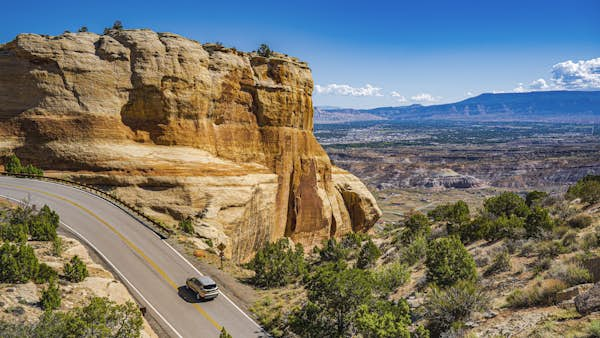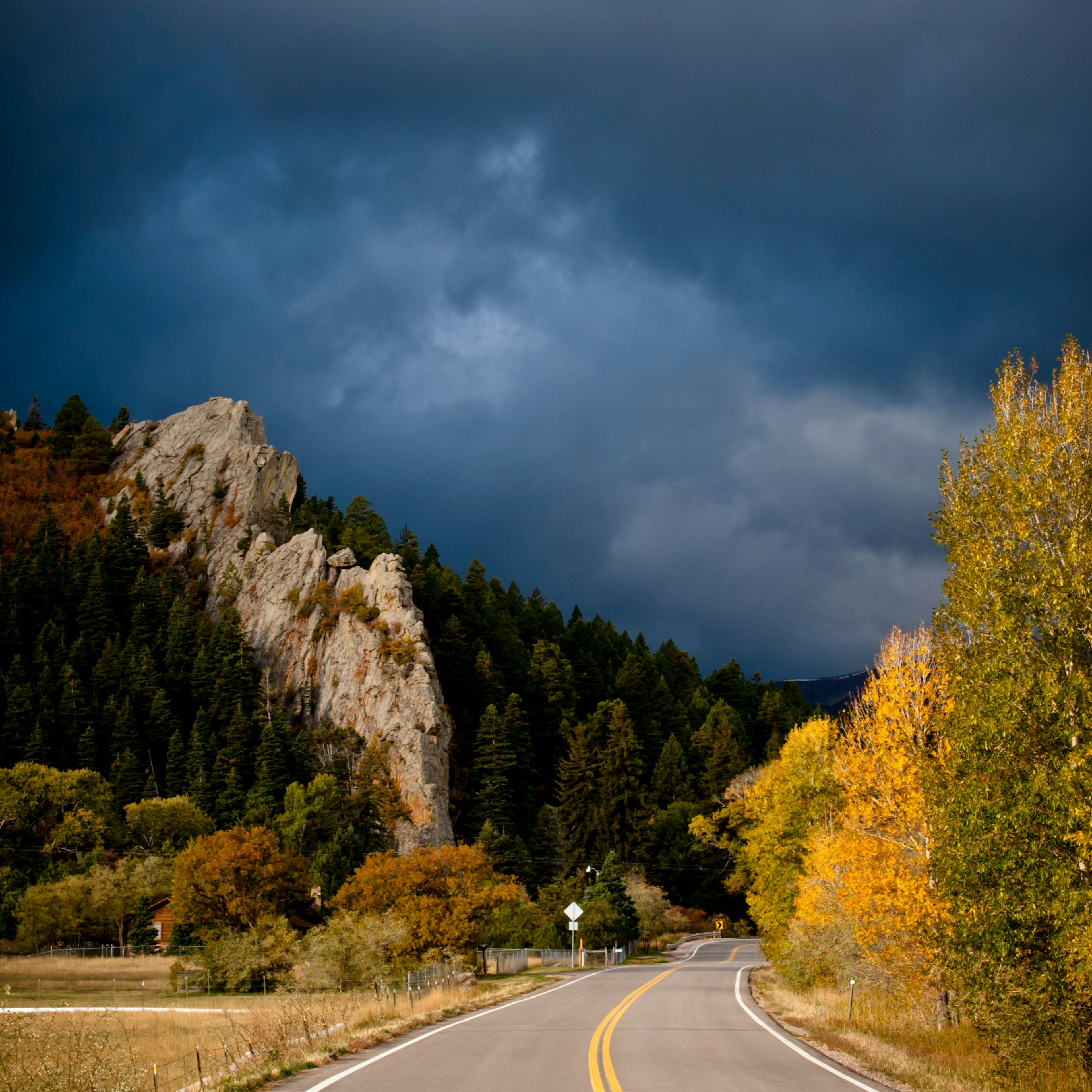The best road trips in Colorado
8 min read
Stretching from the Eastern Plains to the Rocky Mountains, Colorado is rightly famous for its breathtaking landscapes. Crossing this rugged state will take you past soaring mountains, sun-drenched plains, red rock mesas and high-altitude deserts – all of which look especially fetching through a car or RV windshield.
Fans of road trips are in for a treat. In between extraordinary vistas, tempting stops invite you to pull over – charming Colorado towns, scenic lakes, unexpected historic sites and outdoor recreation opportunities of every kind, including some fabulous hikes. And endless miles of well-maintained Scenic and Historic Byways provide easy access to the state’s diverse attractions.
Do some planning to make sure you catch Colorado at the best time of year, then grab your keys and pull onto the highway… Here are the best road trips in Colorado.
1. Over Independence Pass
Best for road-trippers in a rush
Twin Lakes–Aspen; 27 miles
The ribbon of road between the historic township of Twin Lakes and the swanky mountain town of Aspen forms the backbone of one of Colorado’s most epic drives. Along this part of the Top of the Rockies Scenic Byway, the vistas are cinematic in scale. Swatches of snow are often visible along the ridges, just below the knife edge of peaks, and tundra vegetation flourishes at the top of the pass. Peaking at 12,095ft, you’ll be on the edge of the Continental Divide, facing views like real-life IMAX moments.
The pass is closed in the winter, from October to May, but for the rest of the year, the drive is short and sweet – and we recommend taking your time. Check out Twin Lakes Reservoir, an angler’s and paddleboarder’s dream. The lakeshore is dotted with historic ruins, including the remains of Interlaken, once Colorado’s largest resort, built in 1879.
And don’t miss dropping into Independence near Aspen – a ghost town dotted with weathered wood cabins. This was the first mining site in the Roaring Fork Valley, and it offers an evocative window back in time.
Detour: For added endorphins, go for a hike on 14,440ft Mt Elbert. This is one of the “easier” fourteeners in the state but start your hike early to make it to the summit and back in one day.

2. Top of the Rockies
Best for big mountain views
Minturn–Aspen; 115 miles
If you liked the drive over Independence Pass, extend the journey to take in the rest of this Scenic Byway. One of the highest roads in the US, the route seldom drops below 9000ft as it follows the mountaintops. You’ll go through three spectacular mountain passes, cross the Continental Divide, take in two Colorado giants – Mt Elbert and 14,428ft Mt Massive – and roll through historic towns in central Colorado.
And if outdoor recreation is your thing, the route passes through three National Forests offering countless opportunities to hike, climb, fish and ski. Not bad for a single day’s drive! Along the way, tiny Minturn is big on small-town charm, while historic Leadville offers the chance to learn all about Colorado’s rags-to-riches mining beginnings at the National Mining Hall of Fame.
Twin Lakes, meanwhile, offers the chance to wander through a historic mining camp that once produced gold, silver and other metals. At the end of the tour is Aspen, one of the state’s poshest and most cultured mountain towns – and a must-visit, even if you don’t consider yourself part of the Aspen set.
Planning Tip: In the summer, from June to September, pick up provisions to munch on the drive at Minturn’s bustling farmers market (the kids can pet goats while you shop).

3. Trail Ridge Rd across the Continental Divide
Best for tundra scenery
Estes Park–Grand Lake; 47 miles
Rocky Mountain National Park’s signature drive, the Trail Ridge Road is the highest continuously paved through-road in North America, climbing to 12,183ft. It follows the same path that generations of Ute, Arapaho and Apache people used as a trade route to traverse Milner Pass, crossing the Continental Divide.
Expect outrageous views of snow-capped peaks, meandering streams, tight switchbacks across the Continental Divide, high-country meadows, wildflowers galore and (with luck) some Rocky Mountain wildlife. Be sure to stop at some of the countless turnoffs to explore tundra trails or, at the very least, take selfies from the top of the world. Note that the road is closed by snow from October to May.
Planning Tip: For a short but steep leg stretch, walk the mile-long Alpine Ridge Trail, for giddying views of the Never Summer Mountains.

4. Peak to Peak Hwy
Best year-round road trip
Estes Park–Nederland; 42 miles
Colorado’s first Scenic Byway, the Peak to Peak Hwy is a year-round hit, winding past towering mountains such as 14,255ft Longs Peak and lush alpine valleys, plus a handful of appealing one-horse towns. The road is especially stunning in the fall, when the mountains become a quilt of gold, yellow and orange. This season also brings bugling elks searching for mates and carloads of leaf-peepers.
Set aside a couple of hours for the drive. Before leaving Estes Park, follow the riverwalk or take a spooky ghost tour of the historic Stanley Hotel, reputedly the inspiration for Stephen King’s The Shining. Along the route, consider stopping in Ward, a former boom town and bohemian magnet that has settled into an artfully ramshackle state of disrepair, or Peaceful Valley, notable for its little onion-domed church perched on a hillside. At the end, stroll through Nederland, a hippie holdout known for its quirky shops and colorful cafes.
Planning Tip: Loads of hikes are possible in the national forests and wilderness areas along the route, including trails around Arapaho Peak, Roosevelt Peak and Indian Peak.

5. Santa Fe Trail
Best for history
Bent’s Old Fort National Historic Site–Trinidad; 116 miles
History buffs will love this day-long drive along the Santa Fe Trail, the Old West’s first wagon “highway,” which once extended all the way from Missouri to New Mexico. Views of sun-drenched prairies and wheat fields, sugar-beet farms and railroad yards unfurl on this wide-open two-lane highway, providing a rich mix of history and uplifting backcountry scenery.
The route’s signature sight is the phenomenal Bent’s Old Fort National Historic Site, set beside the Arkansas River. Perched on the erstwhile US-Mexico border, the fort marked a cultural crossroads where Arapahoe, Cheyenne, Mexican and American traders met, mingled and coexisted.
While initially built for trade, the fort was later seized by the US Army – the start of a military presence that remains strong in Colorado to this day. Trade declined as thousands of settlers poured into the frontier following the Louisiana Purchase and a notorious cholera epidemic that greatly affected the region’s Indigenous communities.
In nearby Comanche National Grassland, homestead ruins and original wheel ruts from wagons on the Santa Fe Trail are still visible. Take time to check out the town of Trinidad, too – tucked into a chimney-top mesa, the town was once an important stop on the Santa Fe Trail.
Detour: Another highlight of the Comanche National Grassland is Picketwire Dinosaur Tracksite, the largest documented dinosaur track site in North America. You can see more than 1500 dinosaur footprints, but you’ll need to book a 4WD tour or hike to reach the site.

6. The Hwy of Legends
Best for mining memories
Trinidad–Walsenburg; 82 miles
Steeped in mining folklore and Native American legends, the sleepy towns and majestic mountain passes of the Hwy of Legends provide a beautiful detour from the I-25 throughway, linking Denver to cities to the north and south. You’ll pass through some of southeastern Colorado’s most glorious countryside; budget two hours to drive the route, more if you stop to take in the sights.
Historic Trinidad is one of the shining stars of the route. Its Main Street was an important stop on the Santa Fe Trail, and the spot where Mother Jones later led marches with striking miners. The Trinidad History Museum offers an excellent primer on the town’s backstory.
Standing like forgotten sentinels along the road, you’ll spy rows and rows of coal ovens in Cokedale, which once produced coke for the steel industry. Also stop in Cuchara for its views of the Spanish Peaks and the Great Dikes that jut from meadows to mountains, and La Veta, where there are more churches than paved roads.
This being Colorado, there are plenty of recreational activities to enjoy as well. The Cucharas River offers terrific fishing, while the hiking in the Spanish Peaks Wilderness is some of the best in the state.

7. Trail of the Ancients
Best for Indigenous culture
Mesa Verde National Park–Ute Mountain Tribal Park; 116 miles
The Trail of the Ancients is the only National Scenic Byway dedicated to archaeology. This beautiful and eye-opening route winds through the canyons, mountains and plains once inhabited by Ancestral Puebloans and later nomadic Navajo, Apache and Ute people. Though the route covers just 116 miles, the sites it passes are fascinating and worth lingering over, making this a good multi-day trip.
Mesa Verde National Park is the crown jewel of the route, home to over 5000 archaeological sites, including 600 Ancestral Puebloan cliff dwellings – a guided ranger tour is highly recommended. Just north, the Anasazi Heritage Center has interesting films, hands-on exhibits and artifacts dating to 400 CE.
Elsewhere, the Canyon of the Ancients and Hovenweep National Monument are Ancestral Puebloan treasures that have been largely left alone and are perfect for DIY exploration. And Ute Mountain Tribal Park houses a number of lesser-known cliff dwellings.
Planning Tip: If you visit Ute Mountain Tribal Park, petroglyphs and shards of Native American pottery can seen scattered over the site, but an official guide must accompany all visitors.
This article was first published Sep 18, 2014 and updated Oct 12, 2024.





